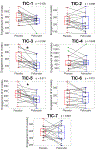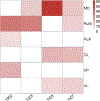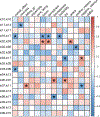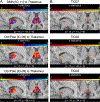Psilocybin induces spatially constrained alterations in thalamic functional organizaton and connectivity
- PMID: 35792293
- PMCID: PMC10749714
- DOI: 10.1016/j.neuroimage.2022.119434
Psilocybin induces spatially constrained alterations in thalamic functional organizaton and connectivity
Erratum in
-
Corrigendum to 'Psilocybin induces spatially constrained alterations in thalamic functional organizaton and connectivity': Neuroimage 2022 Oct 15;260:119434.Neuroimage. 2023 Jul 1;274:120130. doi: 10.1016/j.neuroimage.2023.120130. Epub 2023 May 4. Neuroimage. 2023. PMID: 37148779 No abstract available.
Abstract
Background: Classic psychedelics, such as psilocybin and LSD, and other serotonin 2A receptor (5-HT2AR) agonists evoke acute alterations in perception and cognition. Altered thalamocortical connectivity has been hypothesized to underlie these effects, which is supported by some functional MRI (fMRI) studies. These studies have treated the thalamus as a unitary structure, despite known differential 5-HT2AR expression and functional specificity of different intrathalamic nuclei. Independent Component Analysis (ICA) has been previously used to identify reliable group-level functional subdivisions of the thalamus from resting-state fMRI (rsfMRI) data. We build on these efforts with a novel data-maximizing ICA-based approach to examine psilocybin-induced changes in intrathalamic functional organization and thalamocortical connectivity in individual participants.
Methods: Baseline rsfMRI data (n=38) from healthy individuals with a long-term meditation practice was utilized to generate a statistical template of thalamic functional subdivisions. This template was then applied in a novel ICA-based analysis of the acute effects of psilocybin on intra- and extra-thalamic functional organization and connectivity in follow-up scans from a subset of the same individuals (n=18). We examined correlations with subjective reports of drug effect and compared with a previously reported analytic approach (treating the thalamus as a single functional unit).
Results: Several intrathalamic components showed significant psilocybin-induced alterations in spatial organization, with effects of psilocybin largely localized to the mediodorsal and pulvinar nuclei. The magnitude of changes in individual participants correlated with reported subjective effects. These components demonstrated predominant decreases in thalamocortical connectivity, largely with visual and default mode networks. Analysis in which the thalamus is treated as a singular unitary structure showed an overall numerical increase in thalamocortical connectivity, consistent with previous literature using this approach, but this increase did not reach statistical significance.
Conclusions: We utilized a novel analytic approach to discover psilocybin-induced changes in intra- and extra-thalamic functional organization and connectivity of intrathalamic nuclei and cortical networks known to express the 5-HT2AR. These changes were not observed using whole-thalamus analyses, suggesting that psilocybin may cause widespread but modest increases in thalamocortical connectivity that are offset by strong focal decreases in functionally relevant intrathalamic nuclei.
Keywords: Functional MRI; Functional connectivity; Independent component analysis; Psilocybin; Psychedelics; Resting state; Thalamocortical connectivity; Thalamus.
Copyright © 2022. Published by Elsevier Inc.
Figures








References
-
- Avram M, Müller F, Rogg H, Korda A, Andreou C, Holze F, Vizeli P, Ley L, Liechti ME, Borgwardt S, 2022. Characterizing thalamocortical (dys)connectivity following d-amphetamine, LSD, and MDMA administration. Biol. Psychiatry Cogn. Neurosci. Neuroimaging. doi:10.1016/j.bpsc.2022.04.003. - DOI - PubMed
Publication types
MeSH terms
Substances
Grants and funding
LinkOut - more resources
Full Text Sources
Miscellaneous

